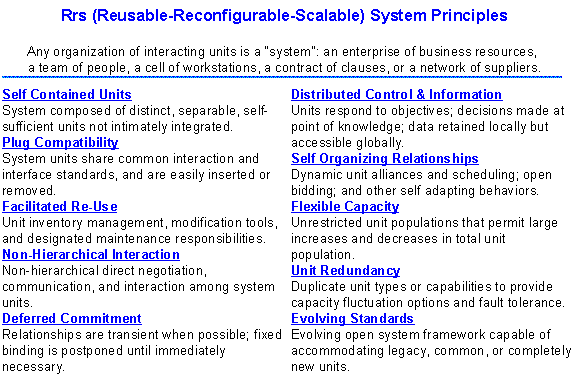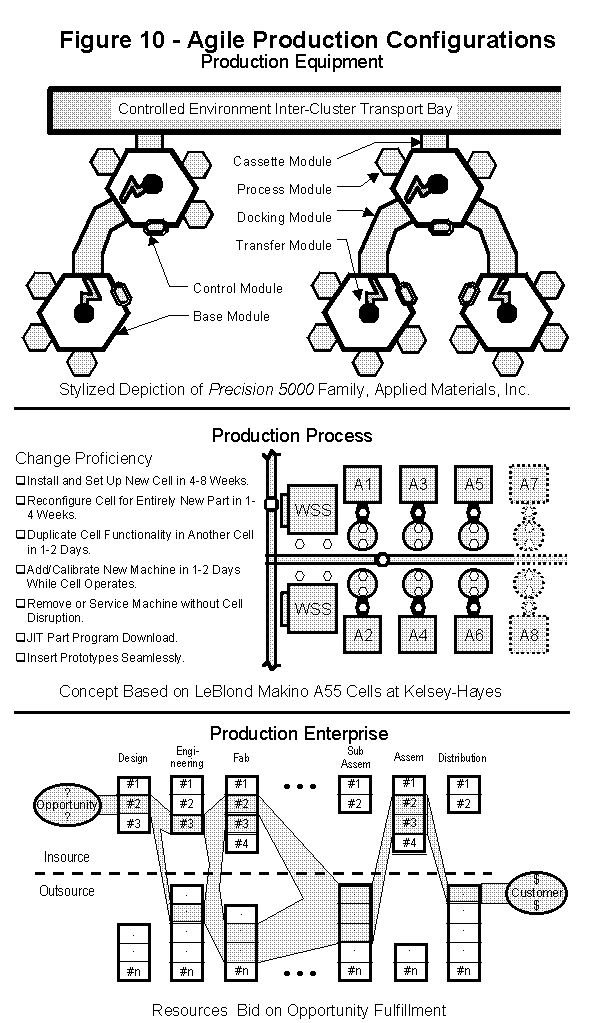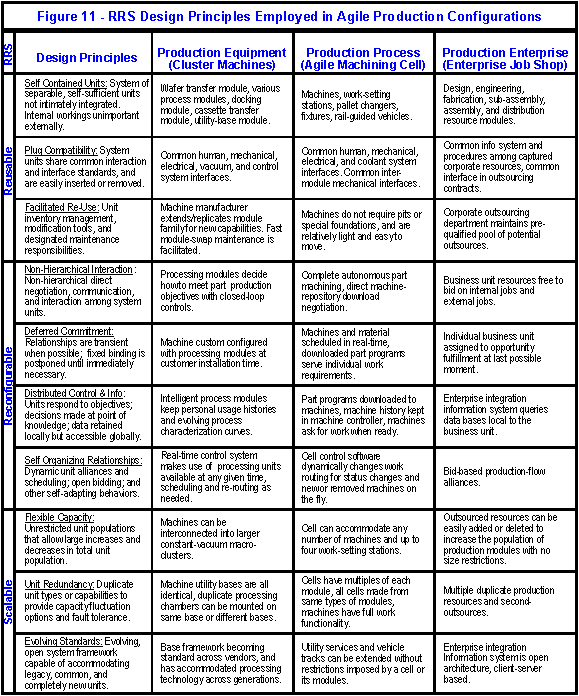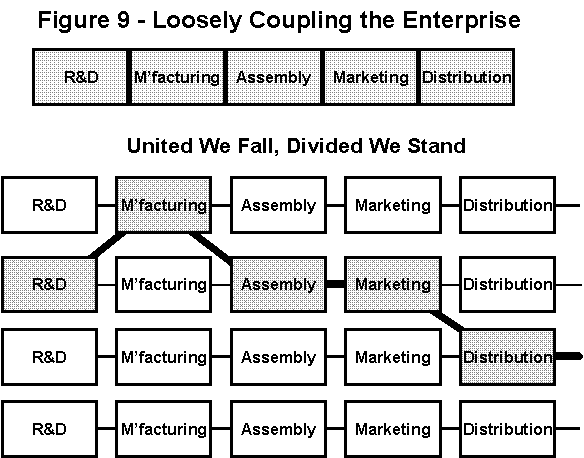 Paradigm Shift
Paradigm ShiftInternational
Agile System Principles
 Paradigm Shift Paradigm ShiftInternational |
Agile System Principles |
|
Features: Home | Library |
Corp Info |
 Design
Principles for Highly Adaptable Business Systems, Design
Principles for Highly Adaptable Business Systems,With Tangible Manufacturing Examples Download entire paper (524kb zipped Word file) |
Excerpted
Overview |
| Abstract Highly adaptable (agile) production systems and business practices are enabled by an engineering design which facilitates the reconfiguration and reuse of common modules across a scalable framework. Examples of agile fixtures, machines, cells, assembly lines, plants, and production organizations are presented; and a common set of ten underlying design principles are shown to be responsible for the high adaptability in each. The principles are system generic, and can be applied to any business practice or process, not just manufacturing and production processes. Finally, a method for capturing and displaying these principles in action is shown which facilitates learning, knowledge transfer, and business-engineering competency development. Contents of Entire Paper (not of this Executive Overview) 1. Introducing Principles for Agile Systems Excerpted Overview When a company decides it is time to change its competencies at leadership and at continued viability it must select and design strategies that will move it (in "agile space") to where it wants to be. The selection of appropriate strategies changes with the times and differs from market to market. In the late '90s appropriate strategies might include concepts like mass customization, virtual enterprise relationships, employee empowerment, outsourcing, supply chain management, "commonizing" production, listening to your customer, and other such. Strategic concepts by themselves are open to a wide range of interpretation, however, and are often interpreted incorrectly. Commonization in shop-floor controls across multiple plants, for instance, does not pay agility dividends if it is interpreted as buying controls from one vendor; empowerment does not pay without an information and support infrastructure; and customer listening does not pay when competitors change the rules. Business strategists recognize the imperative of the agile enterprise, with virtually all popular business writers extolling the need for change proficiency of one kind or another. Of particular note is Richard D’Aveni’s excellent Hypercompetition [2], which focuses on wielding change proficiency as a preemptive business strategy, and Kevin Kelly’s Out of Control [3], which provides fundamental examples for the business engineer who would design and build agile business practices and production systems. Regardless of the strategies chosen, effective implementation employs a common set of fundamental design principles that promote proficiency at change. Designing agile systems, whether they be entire enterprises or any of their critical elements like business practices, operating procedures, supply-chain strategies, and production processes, means designing a sustainable proficiency at change into the very nature of the system. A business engineer is interested in both the statics and the dynamics of these systems - where the static part is the fundamental system architecture and the dynamic part is the day-to-day reengineering that reconfigures these systems as needed. Sustaining a desired opportunistic/innovative profile is dependant upon the agility of these systems, which in turn is impeded or enabled by their underlying architectures. In the next section we discuss Reusable/Reconfigurable/Scalable (Rrs) system strategies. The Figure below provides a set of design principles for these Rrs systems. These principles have emerged from observations of both natural and man-made systems that exhibit Rrs characteristics, with contributions from the Agility Forum's 80-case Agile Practice Reference Base [4], Kevin Kelly's thought-provoking book [3], and the sizable body of knowledge and experience growing out of object oriented and component technology systems design. |
 |
| In the body of this paper we explore the nature of agility in production systems and occasionally the enterprise systems that encompass them; making the argument more than once that agility is a characteristic which emerges from design. Behind each of these systems are "business engineers" responsible for the system’s design - consciously or unconsciously as the case may be. Good engineering is applied science. The design of manufacturing enterprise systems, from production process to business procedure, can result in a more or less adaptable system to the extent that certain design principles are employed. The expression of Rrs design principles explored in the three production systems (figure 10) examined in this paper are assembled in figure 11 in tabular form, showing various applications. |
 |
| Science is born from gathering data, analyzing this data for patterns, making hypothesis on principles, and iterating toward validation. The ten principles employed here have been discovered, refined, and validated in numerous analytical exercises [6]. We have found useful repeatable patterns that appear to govern adaptability. Methods for conducting change proficiency analysis in your production environment, and building customized change proficiency maturity profiles of your competitive agility can be found in "Response Ability - Understanding the Agile Enterprise" [7]. |
 |
| The agile enterprise is adaptable enough to transform itself proficiently into whatever the times require. At least, with the unpredictable and increased pace of change driving businesses out of business today, that is the salvation hoped-for by corporate management. They understand that business is not just about making money, it is also about staying in business. We used to think that making money was all it took to stay in business. Now we know that you can make money right up to the day you become irrelevant - then you are probably the last to know while you are ignored to death. The profit making predictability of any company that wants to outlive its currently successful product family becomes more important and more difficult than ever. The marketplace grows less tolerant of mistakes and inefficiencies, and deep pockets are getting shallower. Borrowing from one successful area of a business to cover problems in another increases the threat to all. Resources that were correct for customer satisfaction only yesterday may no longer be relevant today. With the increased risk to the entire business comes sharpened recognition that every internal resource must either be making profits today or insuring profits tomorrow. Successfully living with fickle markets and unpredictable technological change requires a higher frequency and freedom of resource reconfiguration than in the past. Looking at it from the corporate view, gaining new productive capacity as well as new productive capability through outsourcing has several potential advantages: short term requirements are not burdened with long term costs, capital investment and its associated risk are both eliminated, the learning curve to develop new production competency is eliminated, and unit costs may well be lower. Contract manufacturers and outsource firms are thriving. At least the good ones are. They are focusing on areas where they have a high degree of competency, innovating in these areas to maintain leadership, organizing common-process production facilities applicable to a variety of manufacturing customers, and loosely coupling the elements of production so they can be reconfigured to meet demand fluctuations among their customers. Many reach advantageous scale economies by aggregating similar needs of multiple customers; and in any event spread their risk over a broader base of market servers. Our example of Kelsey-Hayes is a prime example of all of these points. On the internal production downside, operations in large corporations carry baggage filled by many captive years, generally lack local authority to invest in the future, and typically subsidize less effective sister operations. At the corporate level, with or without a conscious corporate strategy, most companies are moving toward agility, some faster than others. They have no choice. Too much inertia impedes the ability to capitalize on market opportunities and handicaps the ability to bring innovation to fruition. The continued survival of any corporation demands a more agile operating capability, and most corporate strategies are following a path in this direction. From the enterprise point of view, agile production is achieved when the makeup and relationships of the enterprise's production resources are easily adapted to the precise needs of the moment, and a fleeting moment it is. The internal strategy breaks the company into independent functional resource units that look like one big job shop (Figure 8) - where units bid on work based on their performance capabilities. Good performance is rewarded with lots of jobs, bad performance is starved to death, and the "system" is self-organizing. Some units learn and improve, others get traded out, shut down, or simply ignored to death. Subsidies are replaced with local profit responsibility and investment authority. The external strategy recognizes that production resources do not necessarily have to be owned and captive, they only have to perform effectively when needed. Outsourcing and contract manufacturing enters the corporate mix of possibilities here (Figure 9). When a good system is set up these outside alternatives are not used as threats to distort internal costing, but rather as a self-organizing influence that brings best-in-class to the table. If management values the retention of captive resources it builds a system that levels the real difference over a reasonable time. Invariably this leads back to local responsibility and local authority. Internal units that must compete with best-in-class external alternatives are allowed to compete on an even basis. And by the same token, they are able to find other customers that will help maintain a balanced production rate, justify new capability investment, and inspire innovative leadership. |
 |
For a fuller exposition of these concepts and principles in action, download the 19 page (524kb) paper that will appear as one of the chapters in the 1999 edition of Maynards Industrial Handbook (McGrawHill). |
|
Features: Home | Library |
Corp Info Send email to |